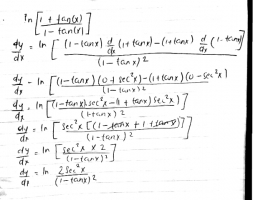You are using an out of date browser. It may not display this or other websites correctly.
You should upgrade or use an alternative browser.
You should upgrade or use an alternative browser.
differentiate: In (1+tanx)/(1-tanx)
- Thread starter lue
- Start date
D
Deleted member 4993
Guest
I donot know where you did make a mistake but you made the algebra complicated unnecessarily. I would start with:
\(\displaystyle \ln \left[ \frac{1+tan(x)}{1-tan(x)}\right] \ = \ ln[1+tan(x)] \ - \ ln[1 - tan(x)] \)
and then differentiate. Try it and see where you land....
Dr.Peterson
Elite Member
- Joined
- Nov 12, 2017
- Messages
- 16,871
You didn't explain what you did, but you appear to have supposed that d/dx ln(f(x)) = ln(f'(x)), which is utterly wrong. If you choose not to simplify first, then at least use the chain rule. (You can then reuse most of the work you did here.)
Steven G
Elite Member
- Joined
- Dec 30, 2014
- Messages
- 14,603
As Dr Peterson pointed out, the derivative of ln(f(x)) is not ln(f'(x))
Looking past that you tried to find the derivative of f(x) (ie what you are taking the derivative of using the quotient rule.) You did the calculus perfectly! The algebra not so good. Algebra is what kills students with Calculus!
You had -(1+ tanx)(-sec^2x) = -(1+tanx)(sec^2x). Why did -sec^2x magically become sec^2x?
(1-tanx)sec^2x - (1+tanx)sec^2x = sec^2x(1-tanx - 1 - tanx) = sec^2x(-2tanx) = -2sec^2xtanx. This is not what you got!
Subhotosh gave you the best way to do this problem.
If you have the log of ANY function, you never ever have to use the product rule, quotation rule or general power rule to compute the derivative.
Looking past that you tried to find the derivative of f(x) (ie what you are taking the derivative of using the quotient rule.) You did the calculus perfectly! The algebra not so good. Algebra is what kills students with Calculus!
You had -(1+ tanx)(-sec^2x) = -(1+tanx)(sec^2x). Why did -sec^2x magically become sec^2x?
(1-tanx)sec^2x - (1+tanx)sec^2x = sec^2x(1-tanx - 1 - tanx) = sec^2x(-2tanx) = -2sec^2xtanx. This is not what you got!
Subhotosh gave you the best way to do this problem.
If you have the log of ANY function, you never ever have to use the product rule, quotation rule or general power rule to compute the derivative.
D
Deleted member 4993
Guest
Make that rarely.....never .............. !!
Dr.Peterson
Elite Member
- Joined
- Nov 12, 2017
- Messages
- 16,871
Lue wrote one sign wrong there, but corrected it on the next line. The algebra is generally correct. The only error is in the calculus at the start.You had -(1+ tanx)(-sec^2x) = -(1+tanx)(sec^2x). Why did -sec^2x magically become sec^2x?

